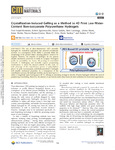Crystallization-Induced Gelling as a Method to 4D Print Low-Water-Content Non-isocyanate Polyurethane Hydrogels

Ver/
Use este enlace para citar
http://hdl.handle.net/2183/29359
A non ser que se indique outra cousa, a licenza do ítem descríbese como Attribution 4.0 International (CC BY 4.0)
Coleccións
- GI-Polímeros - Artigos [32]
- OpenAIRE [366]
Metadatos
Mostrar o rexistro completo do ítemTítulo
Crystallization-Induced Gelling as a Method to 4D Print Low-Water-Content Non-isocyanate Polyurethane HydrogelsAutor(es)
Data
2021Cita bibliográfica
Fanjul-Mosteirín, N.; Aguirresarobe, R.; Sadaba, N.; Larrañaga, A.; Marin, E.; Martin, J.; Ramos-Gomez, N.; Arno, M. C.; Sardon, H.; Dove, A. P. Crystallization-Induced Gelling as a Method to 4D Print Low-Water-Content Non-Isocyanate Polyurethane Hydrogels. Chem. Mater. 2021, 33 (18), 7194–7202. https://doi.org/10.1021/acs.chemmater.1c00913.
Resumo
[Abstract] The use of three-dimensional (3D) printable hydrogels for biomedical applications has attracted considerable attention as a consequence of the ability to precisely define the morphology of the printed object, allowing patients’ needs to be targeted. However, the majority of hydrogels do not possess suitable mechanical properties to fulfill an adequate rheological profile for printability, and hence, 3D printing of cross-linked networks is challenging and normally requires postprinting modifications to obtain the desired scaffolds. In this work, we took advantage of the crystallization process of poly(ethylene glycol) to print non-isocyanate poly(hydroxyurethane) hydrogels with tunable mechanical properties. As a consequence of the crystallization process, the hydrogel modulus can be tuned up to 3 orders of magnitude upon heating up to 40 °C, offering an interesting strategy to directly 3D-print hydrogels without the need of postprinting cross-linking. Moreover, the absence of any toxicity makes these materials ideal candidates for biomedical applications.
Palabras chave
Crystallization
3D printing
Inorganic carbon compounds
Hydrogels
Materials
3D printing
Inorganic carbon compounds
Hydrogels
Materials
Versión do editor
Dereitos
Attribution 4.0 International (CC BY 4.0)
ISSN
0897-4756
1520-5002
1520-5002






